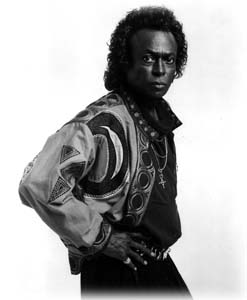![[Metroactive Music]](/music/gifs/music468.gif)
![[Metroactive Music]](/music/gifs/music468.gif)
[ Music Index | Metro | Metroactive Central | Archives ]
Jazz Line
 Fire and Ice: Trumpeter Miles Davis gave birth to the cool. Photo by Richard Rothman
'The Instrumental History of Jazz' CD set tries to live up to its grand claim By Nicky Baxter Skip the overly professorial preface to the new two-CD compilation The Instrumental History of Jazz (N2K Encoded Music). It might reinforce the notion that this music is for intellectuals only. Not true. Sometimes forgotten by students of the genre is the fact that jazz started out as entertainment. Like most histories with sweeping subjects, this one does not, indeed, cannot, live up to the too-ambitious claim of its title. That's an impossible task for a two-CD set, even one with CD-ROM capabilities (complete with video clips). Still, the first disc makes an excellent case for itself as an invaluable, though compressed, overview of the genre. The set's first half begins, necessarily if rather predictably, with Scott Joplin's "Maple Leaf Rag" and concludes with Cecil Taylor's "Enter, Evening." One way to track the form's development is simply to note that Joplin's "Rag" barely exceeds three minutes, while the Taylor composition clocks in at just over 11. Both are piano pieces, but if Joplin's performance only hints at the instrument's capabilities, Taylor's fulfills the promise with an extraordinary virtuoso performance. With the exception of the Original Dixieland Jazz Band's entry, the numbers on the first disc have been carefully chosen. There's no argument that Louis Armstrong, Count Basie, Duke Ellington, Charlie Parker and Dizzy Gillespie are required listening for anyone interested in the progression of instrument jazz. "Dippermouth Blues," featuring the Armstrong, is a joyous reminder that collective improvisation didn't begin with Ornette Coleman. This is controlled chaos at its most inspired. While cornetists King Oliver and Armstrong deliver the heaviest blowing, Johnny Dodds (clarinet) and Lil Armstrong (piano) are far from idle onlookers, stoking the fire raging all around them. Swing Notes Representing swing music, the Basie and Ellington ensembles both epitomize what dance bands ought to sound like. The former's signature tune, "One O'Clock Jump," is a straight groove 60 years after Basie and company strode into the studio to lay it down. After the pianist outlines the theme, it's time for his all-stars to flesh things out. Sounding every bit as wide open as the K.C. territory it ruled, the orchestra eschewed the glossiness of Ellington's groups for a rougher sound. Which is not to say the Count Basie Band reveled in primitivism; listen to the precision interplay between soloists Buck Clayton and Lester Young. On the other hand, the Duke's reputation as Mr. Sophistication is not altogether warranted. "East St. Louis Toodle-O" offers some of the dirtiest playing of any era. Cootie Williams' guttural trumpet reeks of the brothel, and his lascivious playing is nearly matched by the rest of the reed section. Some say bebop was a reaction by black jazzmen to white players stealing their swing thunder; others contend it was a dialectical necessity. Whatever the case, New York-bred bop was a more aggressive, self-conscious idiom than any of its predecessors. Like the city itself, this music was blunt, always in a hurry. Philosophically, bop had a tremendous impact. There might have been no Beat generation without it--no hippies, either. The Instrumental History of Jazz includes selections from alto player Charlie "Bird" Parker ("Ko-Ko") and trumpeter Dizzy Gillespie--teamed up with Bird ("Shaw 'Nuff"). Cooling Down The collection next focuses on the "cool school," closely associated with Dave Brubeck, Gerry Mulligan and other L.A.-based musicians. Ironically, it was Miles Davis' Birth of the Cool that announced the arrival of this structurally correct but emotionally vapid sound. Just as bebop was a reaction to swing's stultifying influence, Cool emerged to ice bop's hot fury. Disc 1 winds down with the hard bop of Horace Silver ("Nica's Dream"), Art Blakey & the Jazz Messengers ("Moanin' ") and John Coltrane ("Impressions"). Hard bop substituted the complexities of cool jazz for a simpler, more soulful approach. (A quibble: Even more than Coltrane, tenor player Sonny Rollins, not included here, exemplified the spirit of hard bop.) The concluding piece, Cecil Taylor's "Enter, Evening," straddles the fence, containing elements of all that came before and the new music to come. Side Two Letdown Disc 2 is an iffier proposition. Aiming at comprehensiveness, it must include "jazz-lite." Still, things start out promisingly enough with the Art Ensemble of Chicago's improvisational masterpiece "Full Force." Inexplicably, however, Ornette Coleman, the acknowledged father of free music, is nowhere to be heard. The "Pop/Contemporary" entries are pure pabulum, the absolute nadir being Dave Grusin's "Mountain Dance," though Spyro Gyra's "Morning Dance" runs a close second. In theory, there's nothing wrong with pop-jazz. What's disturbing is its domination of commercial radio. Not even bop conservationist Wynton Marsalis' music has made it past timid programmers. Is The Instrumental History of Jazz worth owning? I'd offer a qualified "yes." Qualified because fans of creative music will find the second disc handy only as a Frisbee, while fans of pop will scratch their heads at the genuine genius found on the first. Yes, because of the CD-ROM video clips of jazz heroes. Either way, this is history you can learn from or simply enjoy. [ Metro | Metroactive Central | Archives ]
| ||||||||||||||||||||||||||||||
Copyright © Metro Publishing Inc. Maintained by Boulevards New Media.